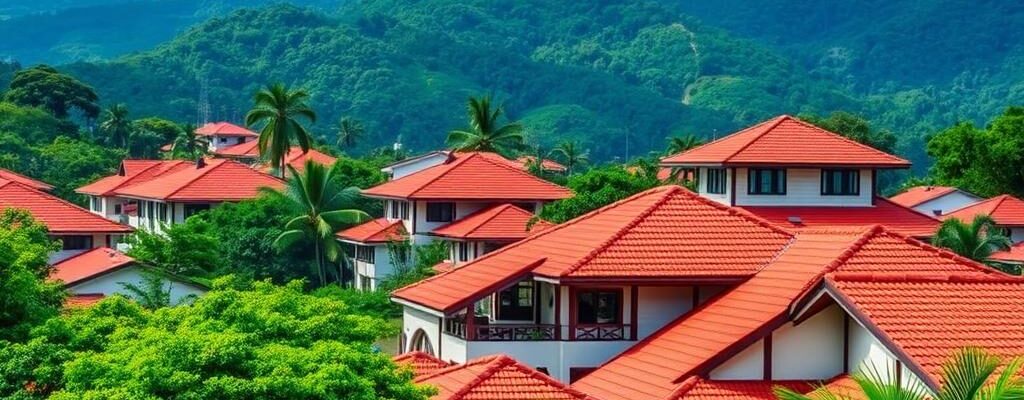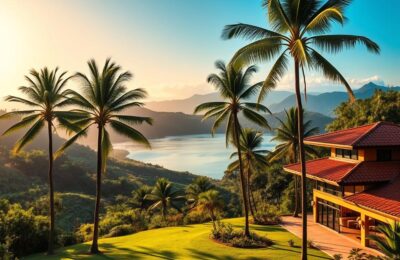Discover the Best Places to Retire in Costa Rica with Residency
Over 500,000 expats have made Costa Rica their home, drawn by its warm climate, welcoming locals, and stable political environment. With more than 70 years of peace, Costa Rica stands out as a haven for those seeking a peaceful retirement.
We explore why Costa Rica has become a top choice for retirees, offering an exceptional lifestyle and quality of life at affordable prices. With its average year-round temperatures ranging from 72 to 82°F, Costa Rica is ideal for those seeking to escape harsh weather conditions.
Costa Rica’s appeal lies in its unique blend of natural beauty, rich culture, and modern amenities, making it an ideal destination for retirees seeking a new and exciting lifestyle.
Why Costa Rica Has Become a Retirement Haven
Costa Rica has emerged as a premier retirement destination, attracting individuals from around the world with its unique blend of tranquility and adventure. We will explore the factors that make Costa Rica an ideal location for retirees.
Political Stability and Safety
Costa Rica has been a beacon of peace and stability in Latin America, having abolished its military in 1948. This commitment to peace has fostered a safe and secure environment, making it particularly appealing to retirees seeking security in their golden years. The country’s low crime rate further enhances its appeal as a retirement destination.
The “Pura Vida” Lifestyle
The “Pura Vida” lifestyle, which translates to “pure life,” is a defining characteristic of Costa Rican culture. It embodies a relaxed and positive approach to life, emphasizing happiness, well-being, and appreciation for simple pleasures. This lifestyle is a significant draw for retirees looking to adopt a healthier and more fulfilling way of living. By embracing “Pura Vida,” retirees can enhance their life and retirement in Costa Rica.
Natural Beauty and Biodiversity
Costa Rica is renowned for its extraordinary natural beauty and biodiversity, featuring pristine beaches, lush rainforests, and vibrant wildlife. The country’s pleasant year-round climate, averaging 72-82°F, creates ideal conditions for an active retirement lifestyle. Retirees can enjoy a wide range of outdoor activities, from surfing and hiking to birdwatching and fishing, making Costa Rica an ideal location for nature lovers.
The combination of political stability, the “Pura Vida” lifestyle, and natural beauty makes Costa Rica a haven for retirees. With its variety of residency options, Costa Rica offers a unique opportunity for individuals to live a fulfilling life in a beautiful and secure environment.
Understanding Costa Rica’s Residency Options
The government of Costa Rica has established several residency programs tailored to the needs of retirees. Costa Rica offers a variety of residency options to suit the needs and circumstances of applicants.
Pensionado Program
The Pensionado Program is designed for retirees with a stable monthly income from a pension or Social Security. To qualify, applicants must have a minimum of $1,000 per month in lifelong retirement income.

Rentista Residency
A “Rentista” must have an income of at least $2,500 per month, which must be deposited into a local bank account on a monthly basis. This visa can be renewed every two years, and after three years, applicants can apply for permanent residence.

Investment Residency
The Inversionista plan reduces the required investment to obtain residency status from $200,000 to $150,000, allowing for the purchase of real estate. This makes it more accessible for retirees looking to invest in property.

Each of these residency options offers a path to permanent residency after three years, along with various tax benefits, including the fact that Costa Rica does not tax foreign-sourced income.
Healthcare System for Retirees in Costa Rica
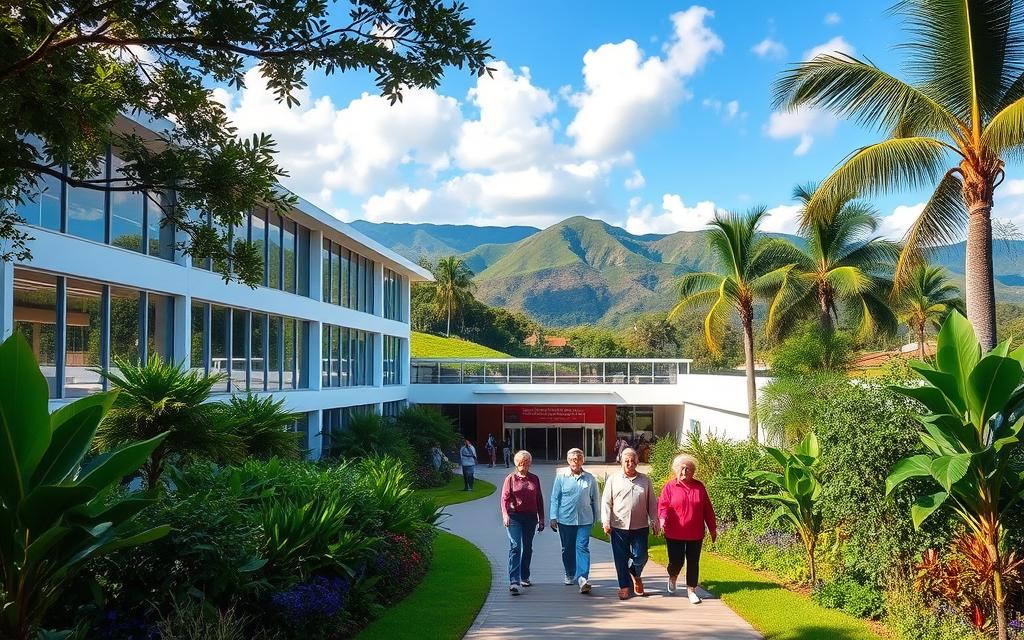
With its reputation for excellence, Costa Rica’s healthcare system is a significant draw for retirees seeking quality medical care. The country’s healthcare system has been ranked highly by the World Health Organization, placing it 36th in the world, just above the United States, in their 2000 survey.
Public Healthcare (Caja)
Costa Rica’s public healthcare system, known as Caja, provides comprehensive coverage to retirees with residency. For a monthly fee based on income, typically ranging from $75 to $150, retirees can access a wide range of medical services. The public healthcare system comprises a network of hospitals and clinics nationwide, ensuring retirees have access to essential medical care.
Private Medical Facilities
In addition to the public healthcare system, Costa Rica boasts a robust private healthcare sector. World-class facilities like Clinica Biblica and CIMA hospitals offer high-quality medical care, often with English-speaking doctors. These private facilities have received international accreditation, ensuring that retirees receive top-notch care. The cost of private healthcare in Costa Rica is significantly lower than in North America, with doctor visits typically costing between $50 and $80, and specialist consultations ranging from $100 to $150.
Medical Tourism Advantages
Costa Rica has become a popular destination for medical tourism, particularly for dental work, cosmetic procedures, and other elective treatments. The country’s high-quality medical facilities, combined with lower costs, make it an attractive option for retirees seeking medical care. Procedures in Costa Rica can cost 50-70% less than in the United States, making it an economical choice for retirees looking to maintain their health without breaking the bank.
Cost of Living for Retirees
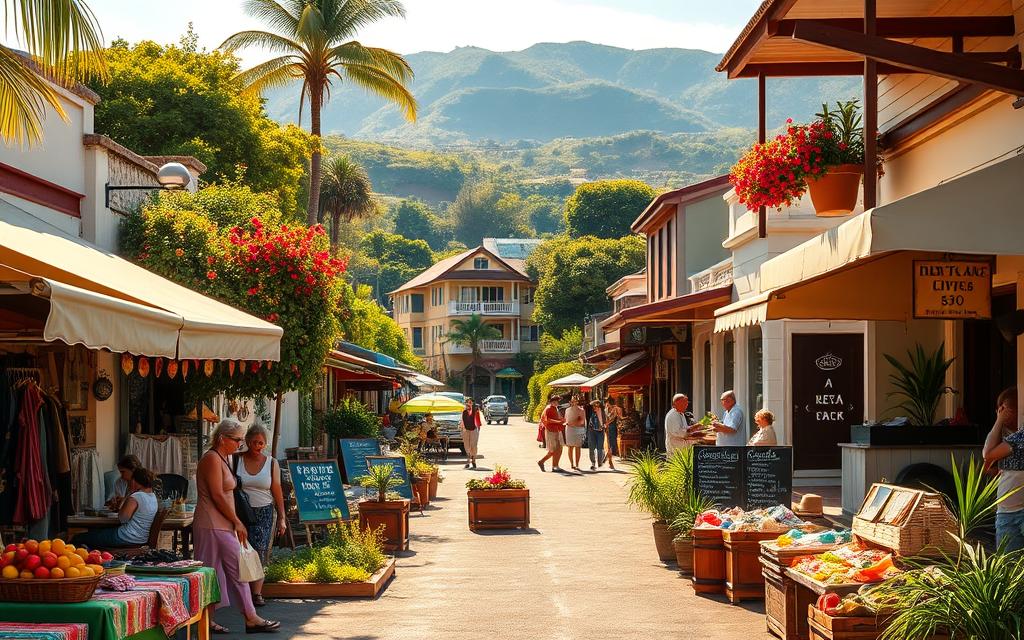
One of the primary attractions for retirees in Costa Rica is its affordable cost of living. The country offers a unique blend of affordability and quality of life, making it an ideal destination for those looking to retire abroad.
Monthly Budget Breakdown
A couple can live comfortably near the beach on about $1,500 to $2,500 per month, excluding housing costs. This includes expenses such as food, utilities, gas, and internet. The average monthly living cost in Costa Rica is approximately $781 for one person and $2,832 for a family of four. For detailed information on residency options, including the Pensionado program, visit this resource.
Housing Costs: Renting vs. Buying
Housing costs in Costa Rica vary significantly depending on the location and amenities. Rent can range from $500 to $2,000 monthly. Purchasing property is also an option, with costs varying for condos, homes, and land in popular retirement destinations. Considerations include property taxes and maintenance costs.
Tax Benefits for Foreign Retirees
Costa Rica offers significant tax advantages for foreign retirees. The country does not tax foreign-sourced income, including Social Security benefits, pensions, and investment income. This makes Costa Rica an attractive destination for retirees looking to maximize their retirement savings.
Best Places to Retire in Costa Rica with Residency
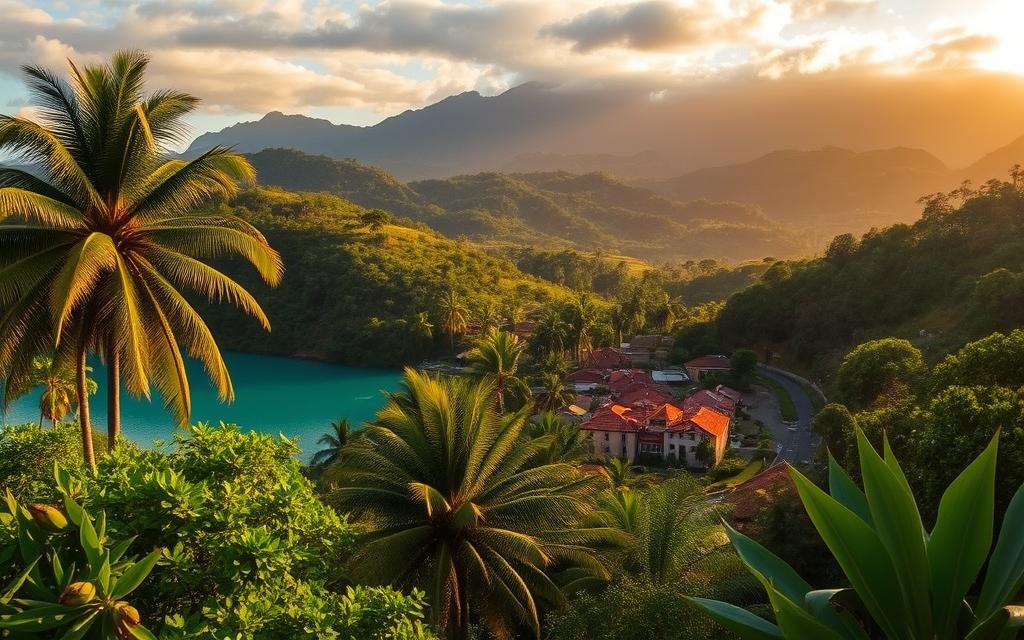
As a popular retirement destination, Costa Rica boasts numerous regions, each with its distinct character and advantages. When considering where to retire in Costa Rica, it’s essential to evaluate various factors that impact your quality of life.
Factors to Consider When Choosing a Location
When choosing a location in Costa Rica, retirees should consider several key factors, including climate preferences, proximity to healthcare facilities, and lifestyle priorities. For instance, some may prefer the dry climate of Guanacaste, while others may enjoy the cooler temperatures of the Central Valley.
To make an informed decision, consider the size and character of expat communities in different regions, as well as the local infrastructure and accessibility. You can find more information on residency requirements and the duration of stay outside of Costa Rica on theJaros CR website.
Additionally, think about the proximity to amenities like shopping, restaurants, and entertainment options, which can vary significantly between urban areas and more remote locations. Property value considerations are also crucial, as homes in regions like Guanacaste have historically appreciated well and are more liquid should retirees need to sell.
By carefully evaluating these factors, retirees can choose a location that suits their needs and enhances their overall retirement experience in Costa Rica.
Retiring in the Central Valley Region
With its temperate climate and picturesque landscapes, the Central Valley is an attractive destination for retirement. The region sits at elevations of 3,000-4,000 feet, offering a temperate climate that many retirees find ideal, with daytime temperatures typically in the 70s to low 80s year-round.
Atenas: “Best Climate in the World”
Athens is often touted as having the “best climate in the world,” with mild temperatures year-round and low humidity. It’s a quiet town within easy driving distance of San José, appreciated for its relaxed pace of life and strong sense of community.
Grecia: Charming Mountain Town
Grecia offers an authentic Costa Rican lifestyle with modern conveniences. Known for its charming red metal church and central park, it’s a clean, safe, and relatively affordable town, making it a favorite among budget-conscious retirees. For more information on tax benefits for retirees in Costa Rica, you can visit Jaros CR.
San Ramón: Cultural Hub
San Ramón is a mid-sized city that serves as a hub for art, education, and cultural events. Home to a university and several museums, it provides an intellectual and creative atmosphere. The growing expat community has developed numerous clubs and social events, creating a supportive network for newcomers.
The Central Valley region, with towns like Atenas, Grecia, and San Ramón, offers retirees a mix of natural beauty, cultural richness, and community life, making it an ideal place to retire in Costa Rica.
Pacific Coast Retirement Destinations
Costa Rica’s Pacific Coast offers a diverse range of retirement destinations that cater to different lifestyles and preferences. The region is renowned for its stunning beaches, vibrant communities, and excellent amenities that cater to retirees.
Tamarindo: Beachfront Living
Tamarindo is a vibrant beach town on the Pacific Coast, known for its laid-back atmosphere and active social scene. Retirees are drawn to Tamarindo for its strong expat presence and wide variety of recreational options.
Playas del Coco and Playa Hermosa
Playas del Coco is a bustling hub with numerous activities, shopping, and dining options. In contrast, Playa Hermosa offers a quieter, more upscale setting, boasting Blue Flag status for its exceptional environmental standards.
Jaco: Accessibility and Amenities
Jaco is one of the most accessible beach towns in Costa Rica, located just 90 minutes from San José. It offers a range of amenities, from medical facilities to shopping centers, making it convenient for retirees.
The Pacific Coast of Costa Rica is an ideal retirement destination, offering a blend of beachfront living, community engagement, and access to a range of amenities. Whether you prefer the vibrant atmosphere of Tamarindo, the tranquility of Playa Hermosa, or the convenience of Jaco, there’s a retirement destination on the Pacific Coast to suit your lifestyle.
Southern Pacific Zone for Retirees
The Southern Pacific Zone, also known as Costa Ballena, is a haven for retirees seeking a tranquil and nature-centered lifestyle. This region offers a unique blend of stunning natural beauty, rich biodiversity, and a relaxed atmosphere, making it an ideal destination for those looking to unwind and enjoy their retirement.
Dominical and Uvita: Natural Paradise
Dominical and Uvita are two coastal towns in the Southern Pacific Zone that have become popular among retirees. Dominical is known for its laid-back surf culture and bohemian vibe. At the same time, Uvita offers more infrastructure and services, including the famous Whale’s Tail beach formation and Marino Ballena National Park. These destinations appeal to eco-conscious retirees who value a tranquil and natural environment.
Ojochal: Culinary Destination
Ojochal is a unique retirement destination known for its international culinary scene. Expats from around the world have established restaurants serving diverse cuisine, creating a vibrant food culture amidst the jungle setting. This charming town offers a blend of natural beauty, cultural experiences, and gastronomic delights, making it an attractive choice for retirees who appreciate good food and a relaxed lifestyle.
The Southern Pacific Zone offers a strong sense of community, with expats often forming close-knit groups that provide support and social connections. The region’s cooler microclimate, particularly in the hills above the coastal towns, is another draw for retirees who enjoy pleasant temperatures and spectacular ocean views.
Caribbean Coast Retirement Options
Costa Rica’s Caribbean coast is a hidden gem for retirees seeking a blend of cultural diversity and natural beauty. This region offers a distinctly different cultural experience and lifestyle compared to the Pacific side, influenced by Afro-Caribbean heritage.
Puerto Viejo: Cultural Diversity
Puerto Viejo is a culturally diverse community with a unique blend of Latin, Caribbean, and indigenous influences reflected in its music, cuisine, and overall atmosphere. Retirees who value diversity, a slower pace of life, and access to beautiful, less-developed beaches often choose Puerto Viejo.
Cahuita: Relaxed Lifestyle
Cahuita is a more laid-back alternative to Puerto Viejo, offering a charming village atmosphere and proximity to Cahuita National Park. The town offers a relaxed lifestyle, perfect for retirees seeking to unwind and connect with nature.
The Caribbean coast also boasts spectacular beaches, including pristine stretches like Punta Uva and Manzanillo, which offer some of the most beautiful coastline in the country. The lower cost of living on the Caribbean side compared to many Pacific coast destinations makes it attractive for budget-conscious retirees.
The unique weather patterns of the Caribbean coast, with more consistent rainfall throughout the year but often beautiful mornings, are another factor to consider. Typically, retirees who thrive in this region are those seeking a more bohemian lifestyle, cultural diversity, and a stronger connection to nature rather than modern amenities.
Building Your Expat Community
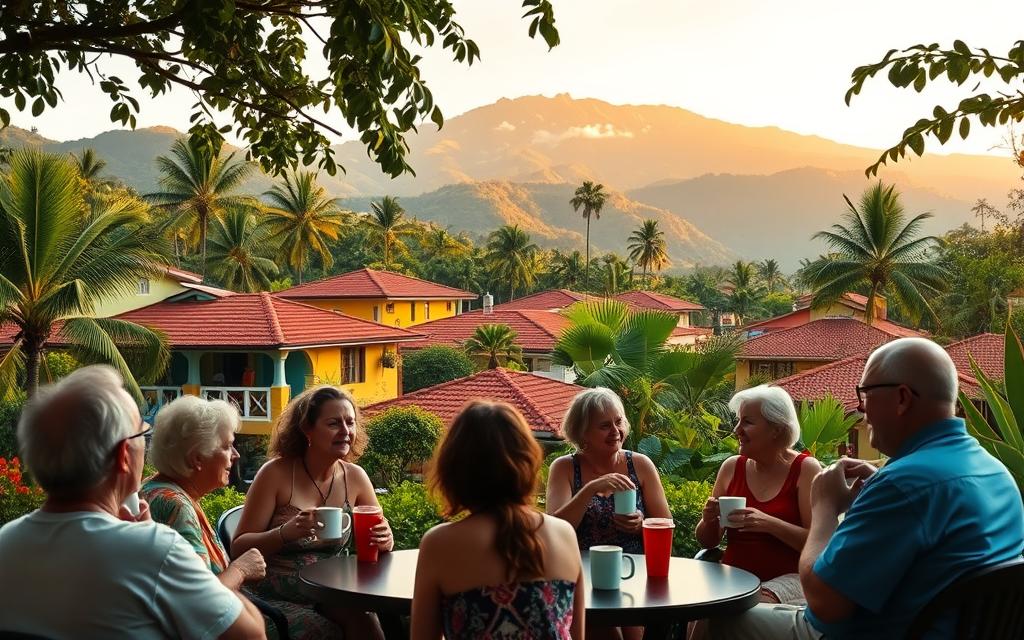
Creating a social network in Costa Rica is crucial for retirees, offering both practical support and emotional well-being during the transition to a new country. As you settle into your new life, you’ll find that Costa Rica has thriving expat communities in nearly every region.
Connecting with Fellow Retirees
Many expats connect through Facebook groups, forums, and local meetups. For instance, towns like Atenas, Tamarindo, Grecia, and Uvita have well-established networks that help newcomers adjust. These platforms provide valuable information, support, and friendship, making the transition smoother. You can also join organized groups like the Association of Residents of Costa Rica, which offers resources, meetings, and support specifically for foreign residents.
Integrating with Local Culture
Integration with local Costa Ricans, or “Ticos,” is highly encouraged to enrich your retirement experience. Learning Spanish, even at a basic level, significantly enhances your experience and fosters better relationships. Participating in community activities, volunteering, or joining social clubs are excellent ways to build meaningful connections with both expats and locals. By striking a balance between expat friendships and local relationships, you can cultivate a rich social network that enriches your life in Costa Rica.
Practical Considerations for New Residents
As you settle into your new life in Costa Rica, several practical considerations will enhance your retirement experience. Managing your finances, navigating transportation options, and integrating into the local community are essential aspects to consider for a smooth transition.
Banking and Finances
Understanding Costa Rica’s banking system is vital for managing your retirement funds. You can maintain accounts in both your home country and Costa Rica, but it’s crucial to discuss the best strategies for transferring funds and managing expenses across currencies with your bank. For more information on residency benefits, including fiscal advantages, visit Jaros CR.
Transportation Options
Costa Rica offers a range of transportation options, from owning a vehicle to using the reliable and inexpensive bus system, taxis, and ride-sharing apps. While main highways are generally in good condition, rural roads may require 4WD vehicles, especially during the rainy season. This mix of transportation options provides easy access to various parts of the country.
Learning Spanish
Learning Spanish, even at a basic level, significantly enhances your daily interactions and cultural integration. Various language learning resources are available, including formal classes at language schools, informal conversation groups, and online options designed for retirees. Embracing the local language enriches your experience and fosters a deeper connection with the Costa Rican community.
Conclusion
As we conclude our exploration of Costa Rica as a retirement destination, it’s clear that this country offers a unique blend of natural beauty, lifestyle, and practicality. Costa Rica has become a haven for retirees, providing an exceptional quality of life at an affordable cost of living.
The country’s residency options, including the Pensionado program, Rentista residency, and Investment residency, offer a relatively straightforward path to establishing a new home. For more detailed information on the Pensionado visa, you can visit https://www.jaroscr.com/costa-rica-pensionado-visa/. Costa Rica’s healthcare system is another significant advantage, providing access to high-quality medical care at a fraction of the costs typically found in North America.
From the temperate climate of the Central Valley to the sunny beaches of Guanacaste and the lush landscapes of the Southern Zone, Costa Rica offers a diverse range of environments to suit different preferences. Prospective retirees need to visit these regions, experience daily life beyond the typical vacation experience, and find the best fit for their lifestyle.
While expatriate life can present challenges, Costa Rica’s supportive communities and expat networks help new residents navigate their transition. For those considering taking the next step, we encourage you to explore Costa Rica further, whether through a scouting trip or by connecting with residents already living there.
For personalized assistance with your Costa Rica retirement plans, you can contact JAROS CR at www.jaroscr.com, email [email protected], or call +(506)7182-8969. Costa Rica offers not just a place to retire, but an opportunity to embrace a new lifestyle that prioritizes well-being, natural beauty, and a balanced approach to life.

